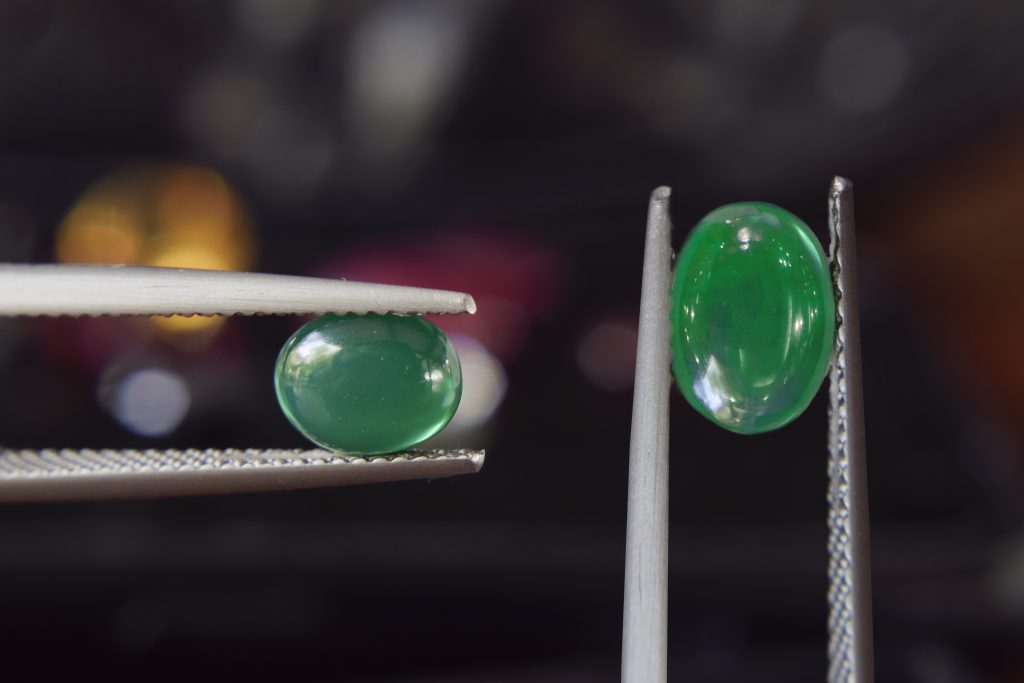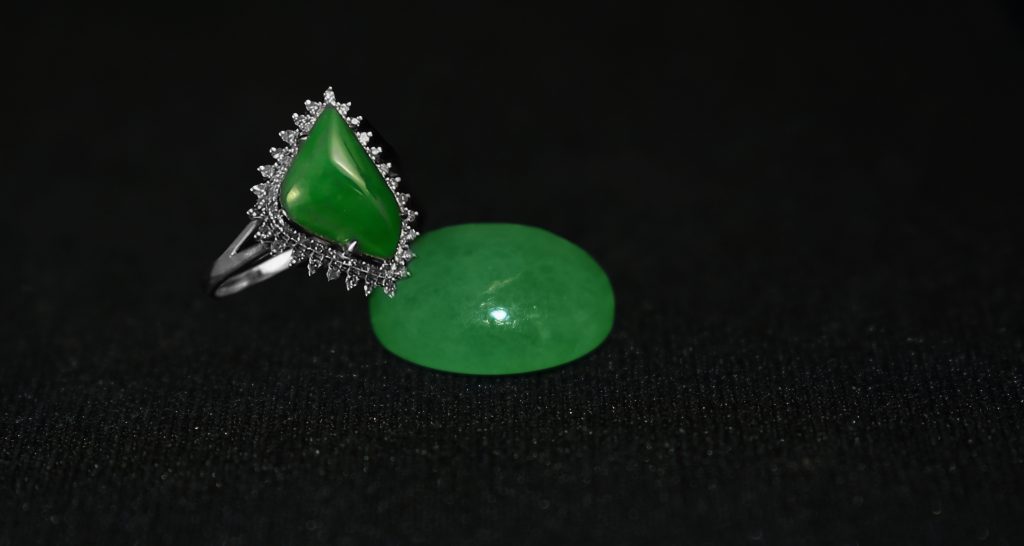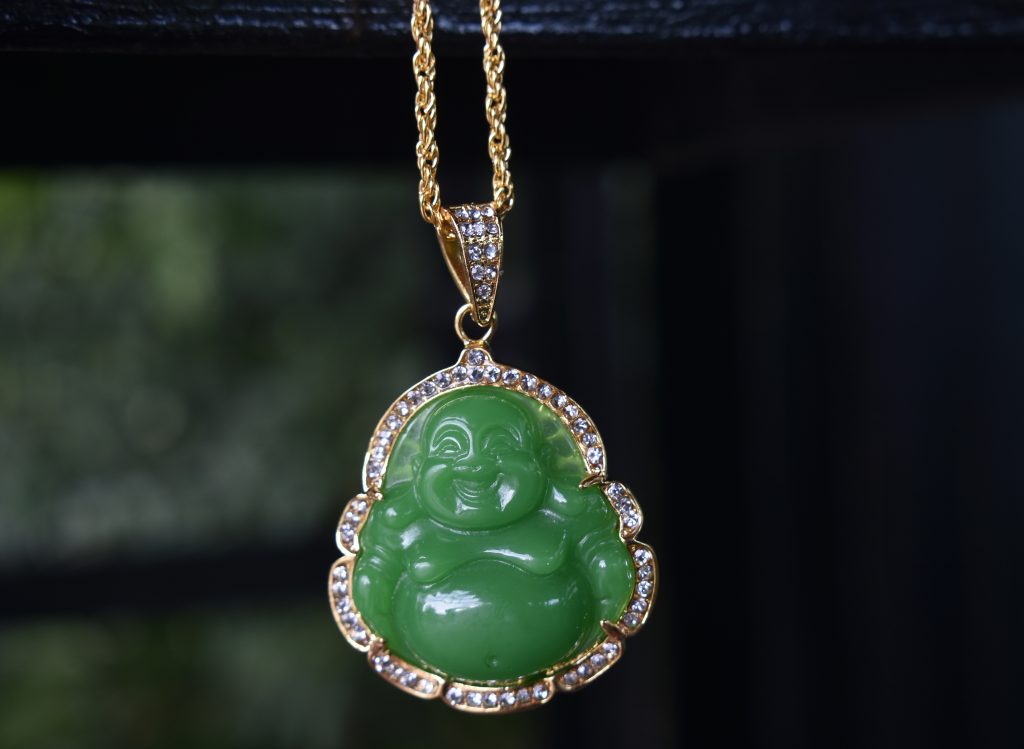
Jade
Jade is a mineral used as jewellery or for ornaments. It is typically green, although may be yellow or white. Jade can refer to either of two different silicate minerals: nephrite (a silicate of calcium and magnesium in the amphibole group of minerals), or jadeite (a silicate of sodium and aluminium in the pyroxene group of minerals).
Etymolog
The English word jade is derived (via French l’ejade and Latin ilia ‘flanks, kidney area’) from the Spanish term piedra de ijada (first recorded in 1565) or ‘loin stone’, from its reputed efficacy in curing ailments of the loins and kidneys. Nephrite is derived from lapis nephriticus, a Latin translation of the Spanish piedra de ijada.

Composition and structure
- Jadeite Composition and Structure: Jadeite is a pyroxene mineral with a complex chemical composition. Its chemical formula is NaAlSi2O6. This formula indicates that jadeite contains sodium (Na), aluminum (Al), silicon (Si), and oxygen (O). However, jadeite can also contain traces of other elements, such as iron, chromium, and manganese, which contribute to its colour variations.
- Nephrite Composition and Structure: Nephrite is a type of amphibole mineral. Its chemical composition is more variable than jadeite but is generally represented by the formula Ca2(Mg,Fe)5Si8O22(OH)2. This formula indicates that nephrite contains calcium (Ca), magnesium (Mg), iron (Fe), silicon (Si), oxygen (O), and hydroxyl (OH) groups.

Colour
Jade is a semi-precious gemstone. It can come from two unique types of crystals—nephrite and jadeite. Nephrite is found in mid- to dark-green, while rarer colours of nephrite include orange and white jade. Nephrite is the more common and less valuable form of jade.
Jadeite is prized for its translucent quality and comes in many shades of green, even a highly sought-after lavender. The rarest examples of jadeite have been described as “moss entangled in melting snow.”
The crystalline structure of the two stones also sets them apart. Nephrite is made of fibrous crystals that interlock in a matted texture, while jadeite comprises grainy crystals that are densely packed. Nephrite is the stronger of the two and is generally used for simpler carving and applications. Jadeite’s harder, denser structure shines and can be delicately carved into intricate designs.

Types of Jade
Jade is a semi-precious gemstone. It can come from two unique types of crystals—nephrite and jadeite. Nephrite is found in mid- to dark-green, while rarer colours of nephrite include orange and white jade. Nephrite is the more common and less valuable form of jade.
Jadeite is prized for its translucent quality and comes in many shades of green, even a highly sought-after lavender. The rarest examples of jadeite have been described as “moss entangled in melting snow.”
The crystalline structure of the two stones also sets them apart. Nephrite is made of fibrous crystals that interlock in a matted texture, while jadeite comprises grainy crystals that are densely packed. Nephrite is the stronger of the two and is generally used for simpler carving and applications. Jadeite’s harder, denser structure shines and can be delicately carved into intricate designs.

Jadeite Jade Quality Factors
Colour
Colour is jadeite’s most important value factor. Because consumers traditionally associate jadeite with the colour green, it surprises some people to learn that it comes in other colours as well—lavender, red, orange, yellow, brown, white, black, and gray.
Transparency
Jadeite’s transparency ranges from completely opaque to semitransparent. The best jadeite is semitransparent, meaning the text you can read through it would be slightly blurred.
Texture
Jadeite has a smooth, even texture that makes people want to touch and hold it. Jadeite’s texture can be fine, medium, or coarse, depending on variations in crystal size and hardness.
Cut
China is the world’s main polishing center for jadeite. Some jadeite from Myanmar is fashioned near its source, in cutting workshops near the open jade markets of Hpakan, Lonkin, Mogaung, and Mandalay.
Size and Weight
Jadeite size is commonly expressed in millimeters. The value of cabochons, beads, and bangle bracelets rises with an increase in size, all other quality factors being equal. With top-quality imperial jadeite, slight differences in size can make large differences in value.
